What Is Market Share?
Market share is the percentage of a particular market served by a particular company. It indicates how dominant the company is in its niche and what potential it has for growth.
More specifically, market share usually refers to revenue market share. (The portion of total industry revenue attributed to a company.)
For example, a company that generates half of its industry’s revenue has a 50% market share.
But you can also measure your market share of specific metrics like:
- Monthly active users
- Website traffic
- Unit sales
Analyses are always based on a certain time scale (e.g., the last financial year). And can also be restricted based on geographic areas, consumer demographics, etc.
It all depends on what's useful for your analysis.
What Is Relative Market Share?
Relative market share shows what proportion of the market you serve compared to your strongest rival. It helps you understand your competitive standing.
For example, if you generate half as much revenue as the industry leader, your relative market share is 50%.
As with standard market share, you can calculate your relative market share of different metrics, for different time ranges, and for different segments.
What Is the Market Share Formula?
The standard market share formula is:
Market share percentage = (company revenue / market revenue) x 100
Let’s say the U.S. smartphone industry generated $80 billion of revenue last year.
If Apple generated $40 billion of those sales, it had 50% market share—(40 billion / 80 billion) x 100 = 50.
To make market share calculations of specific metrics, use this formula:
Market share percentage of metric = (company metric / market metric) x 100
Let’s say the smartphone industry made 1.2 billion shipments last year.
If Apple made 240 million of those shipments, it had 20% market share—(240 million / 1.2 billion) x 100 = 20.
And this is the relative market share formula:
Relative market share percentage = (company market share / strongest competitor’s market share) x 100
Let’s say Apple is the market leader with a 25% market share. And its biggest competitor is Samsung, with a 20% market share.
- Apple’s relative market share is 125%—(25 / 20) x 100). This means they’re the market leader. And their market share is 25% larger than their strongest competitor’s.
- Samsung’s relative market share is 80%—(20 / 25) x 100). Their market share is 20% smaller than their biggest competitor’s.
How to Calculate Market Share
To determine market share, you need to divide your company metric (e.g., revenue) by the equivalent market metric. Then multiply by 100 to get a percentage.
But what data should you use? And where can you find it?
Let’s explain how to calculate market share of different values step by step. We’ll also share a free template you can use.
1. Source Market Data
The market share calculations you can make are typically limited by the market data available.
So, we recommend that you collect market data first. And work from there.
Potential sources include market research tools, databases, and industry reports.
A Google search like this can help you find the data you’re interested in:

If you can’t find data for your niche, try collating it yourself.
For example, you can download your competitors’ financial reports. Then, combine their revenue figures with your own to get a market revenue estimate.
Market revenue estimate = your revenue + competitors’ revenue
Same goes for other metrics, like unit sales.
The more competitors you collect data from, the more accurate your market share calculation will be.
2. Collect Equivalent Company Data
Once you’ve collected your market data, you need to collect the equivalent data from your company.
For example, market revenue and your company’s revenue should relate to the same time range and geographic location.
If you don’t use like-for-like data in your market share calculations, you won’t get a valid result.
3. Apply the Market Share Formula
All that’s left is to use your data in the market share formula for your chosen metric.
As a reminder, it looks like this:
Market share percentage of a metric = (company metric / market metric) x 100
If you want to make sure you get things right, make a copy of our market share calculator in Google Sheets.
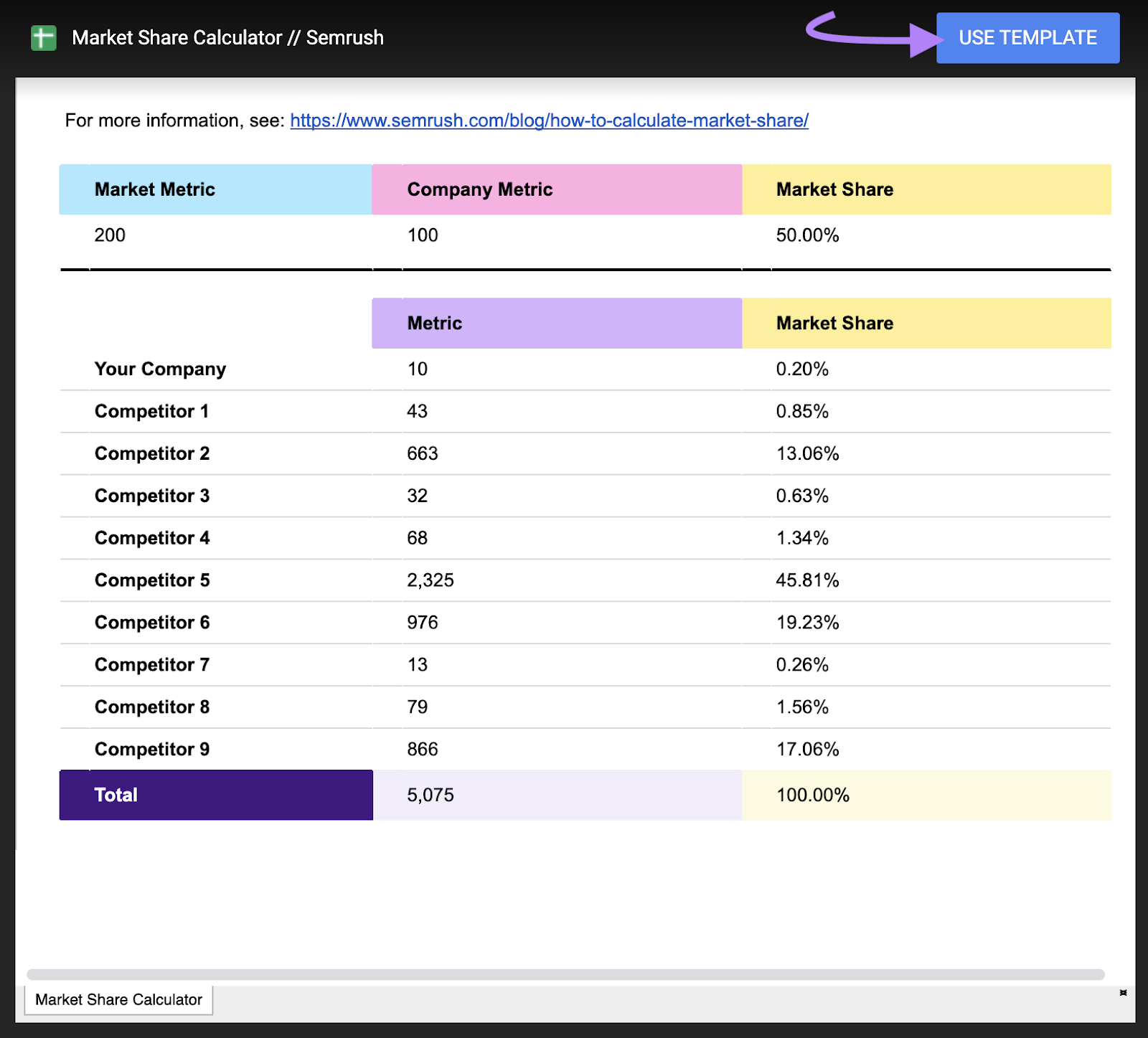
Simply input your market and company data in the upper table.

Or fill out the lower table with your own and your competitors’ data. This allows you to calculate a market data estimate and see each company’s market share.
(We’ve provided enough space for nine competitors, but you can add or delete rows if necessary. Just make sure to adjust the formulas accordingly.)
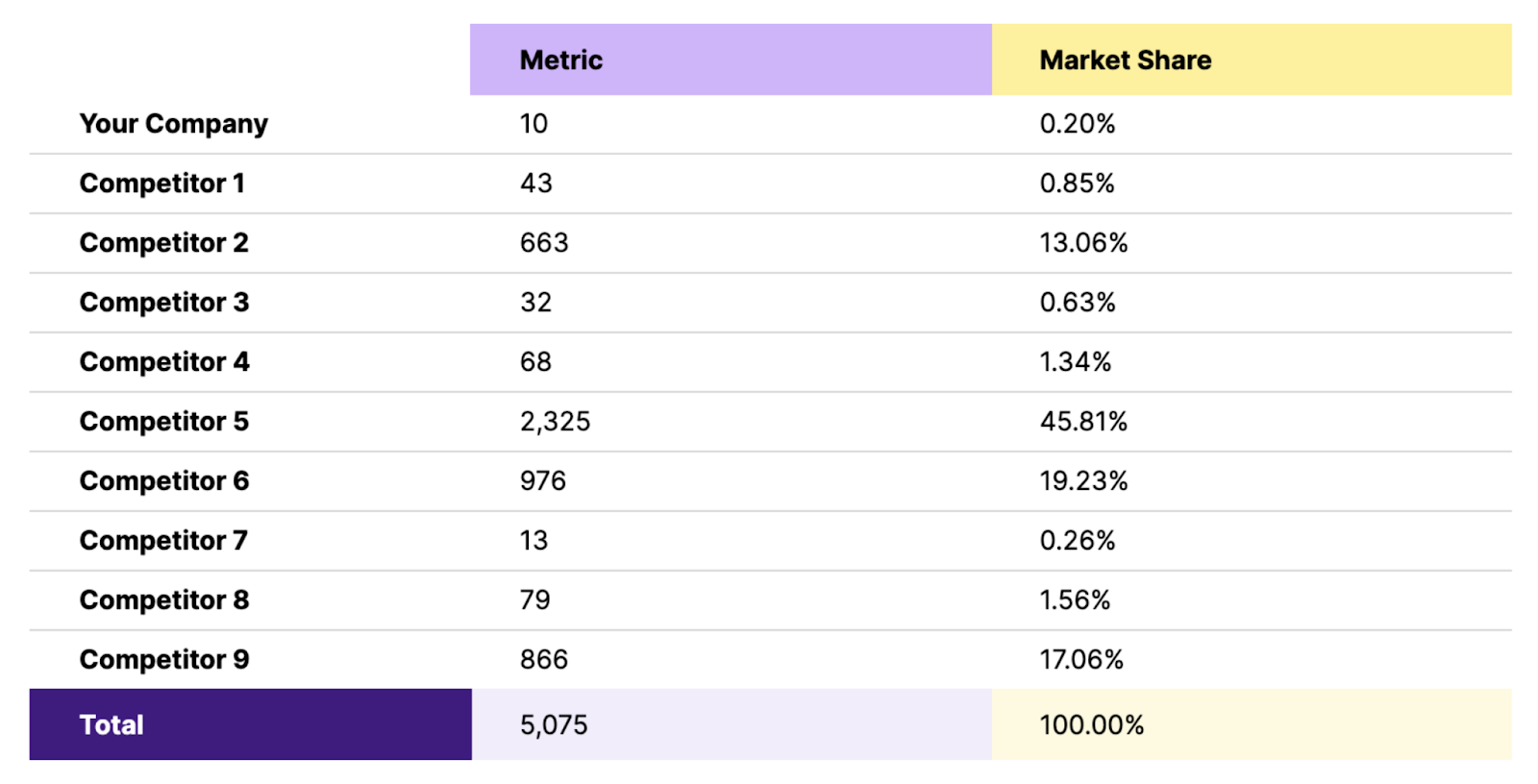
How to Calculate Traffic Share
Traffic share (or web traffic share) represents the portion of visits that go to your website out of all the website visits made in your industry.
This helps you understand how strong your business’s online presence is.
And with Semrush’s Market Explorer tool, you can calculate your traffic share in seconds.
Just click “Find Competitors,” choose your location, and enter your domain.
Then, click “Research a market.”

The tool will identify your biggest traffic competitors and conduct a market analysis. (Based on the time scale and location selected at the top.)
Go to “All Domains” to see your own and your competitors’ share of traffic:
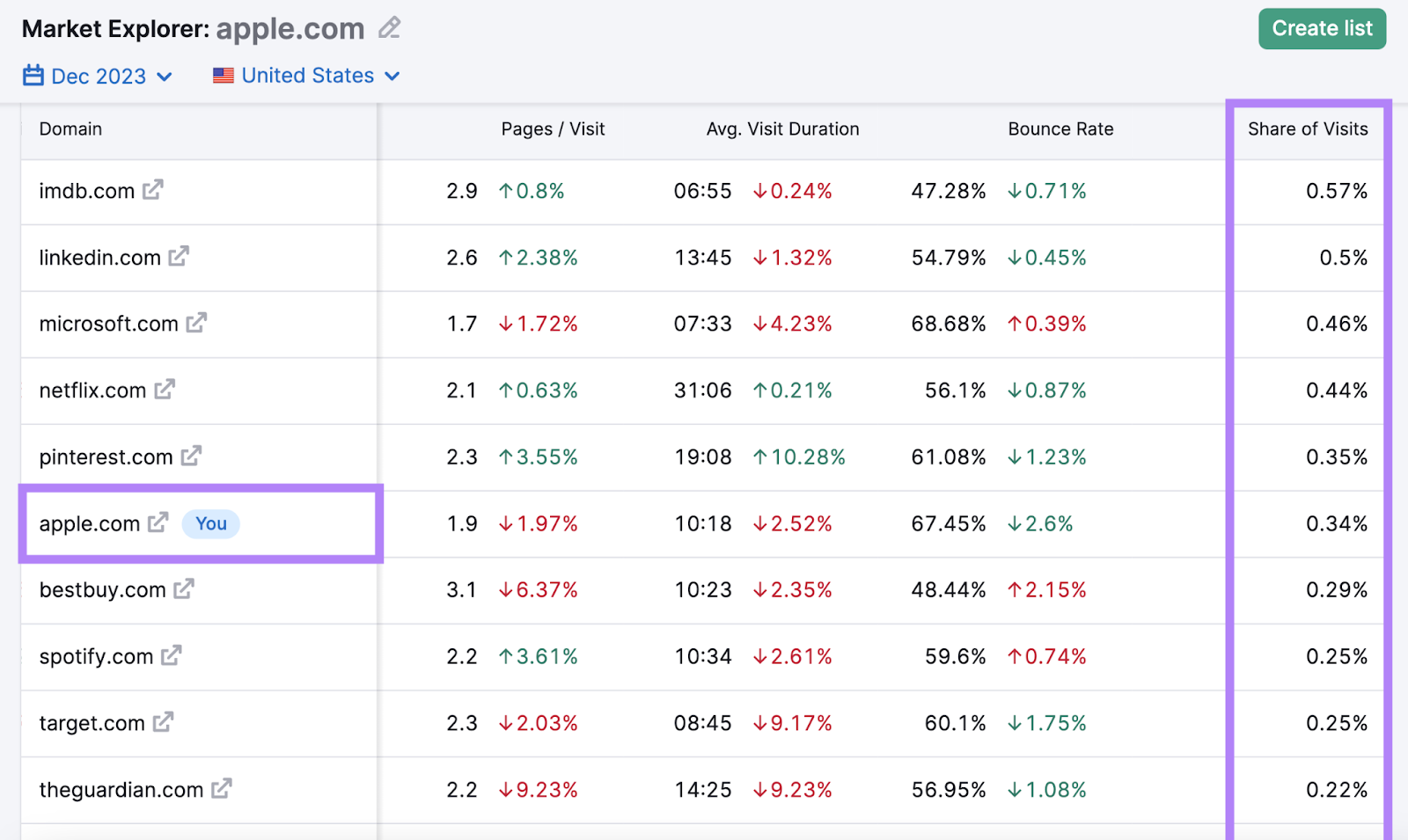
Or go to “Benchmarking” and choose up to five domains to compare.
In the table, you can see each acquisition channels’ share of traffic:
- Total: Visits from any channel
- Direct: Visits made when users type the URL into a browser or use a bookmark
- Referral: Visits from links on external domains
- Organic Search: Visits from unpaid search engine links
- Paid Search: Visits from search engine advertisements
- Organic Social: Visits from unpaid social media links
- Paid Social: Visits from social media advertisements
- Email: Visits from email links
- Display Ads: Visits from display advertisements (e.g., banner ads)
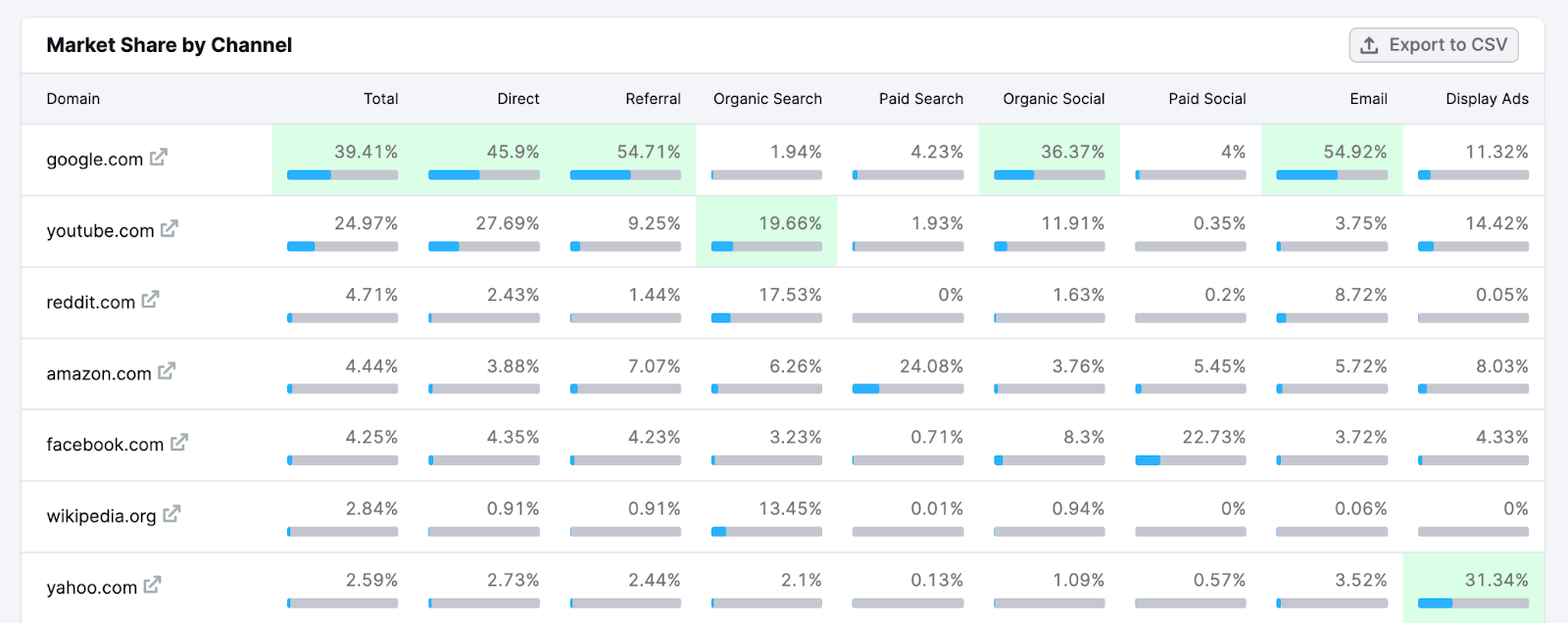
If your market share is low in a particular area, it suggests you’re missing out on potential traffic. So, you might want to revisit your marketing strategy.
For example, if you have a relatively small traffic share in organic search, consider investing more in search engine optimization (SEO).
Market Explorer (and your Semrush .Trends subscription) also gives you access to a variety of other insights. So, make sure to explore all the tools and reports.
How to Increase Your Market Share
Increasing market share is about getting customers to choose you over competitors.
Here are eight tactics you should know about:
Outrank Your Competitors in Search Results
Outranking your competitors for relevant search engine queries (or keywords) is one of the best ways to divert valuable traffic from their sites to your site. To contribute to a higher share of sales.
You can find opportunities with Semrush’s Keyword Gap tool.
Enter your domain and a competitor’s domain.
Then, choose your country and click “Compare.”
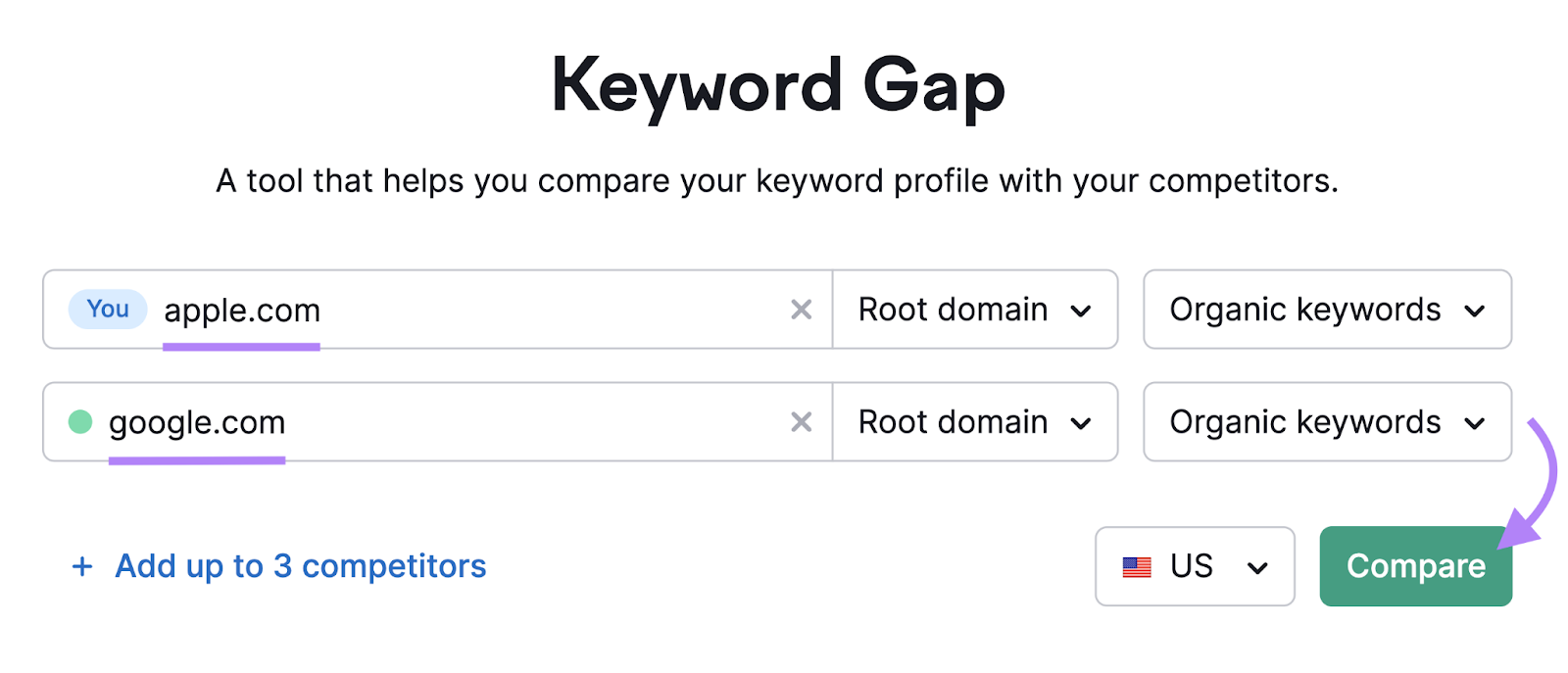
Scroll down to the keyword table and click the “Weak” tab. This shows keywords that the competitor outranks you for.
You can see both of your positions in the table.
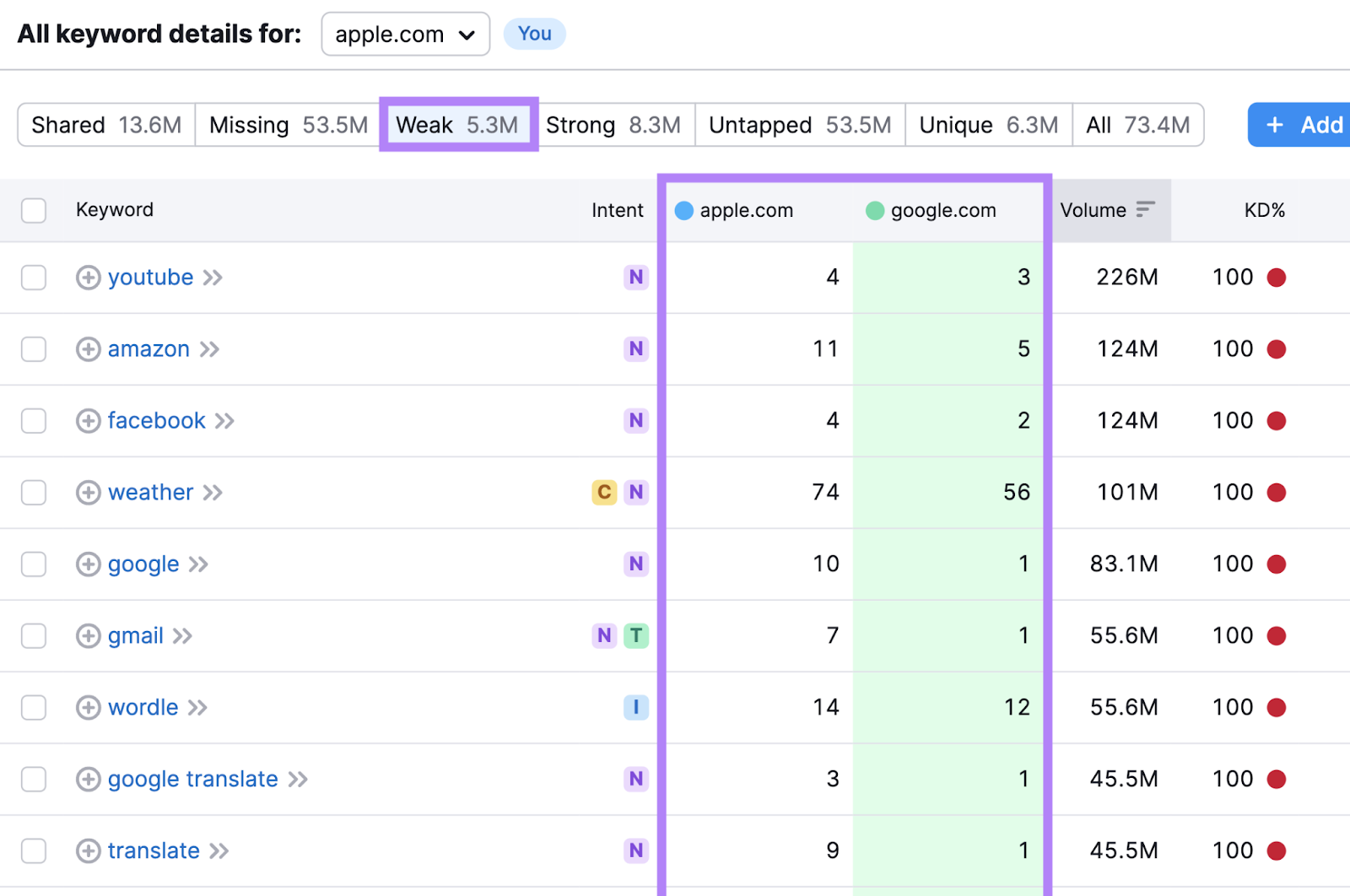
It’s a good idea to prioritize keywords that:
- You already have a high ranking for (so you have fewer positions to gain)
- Have a high search volume (so the potential traffic gains are higher)
- Have with a low difficulty score (this suggests it’ll be easier to improve your ranking)
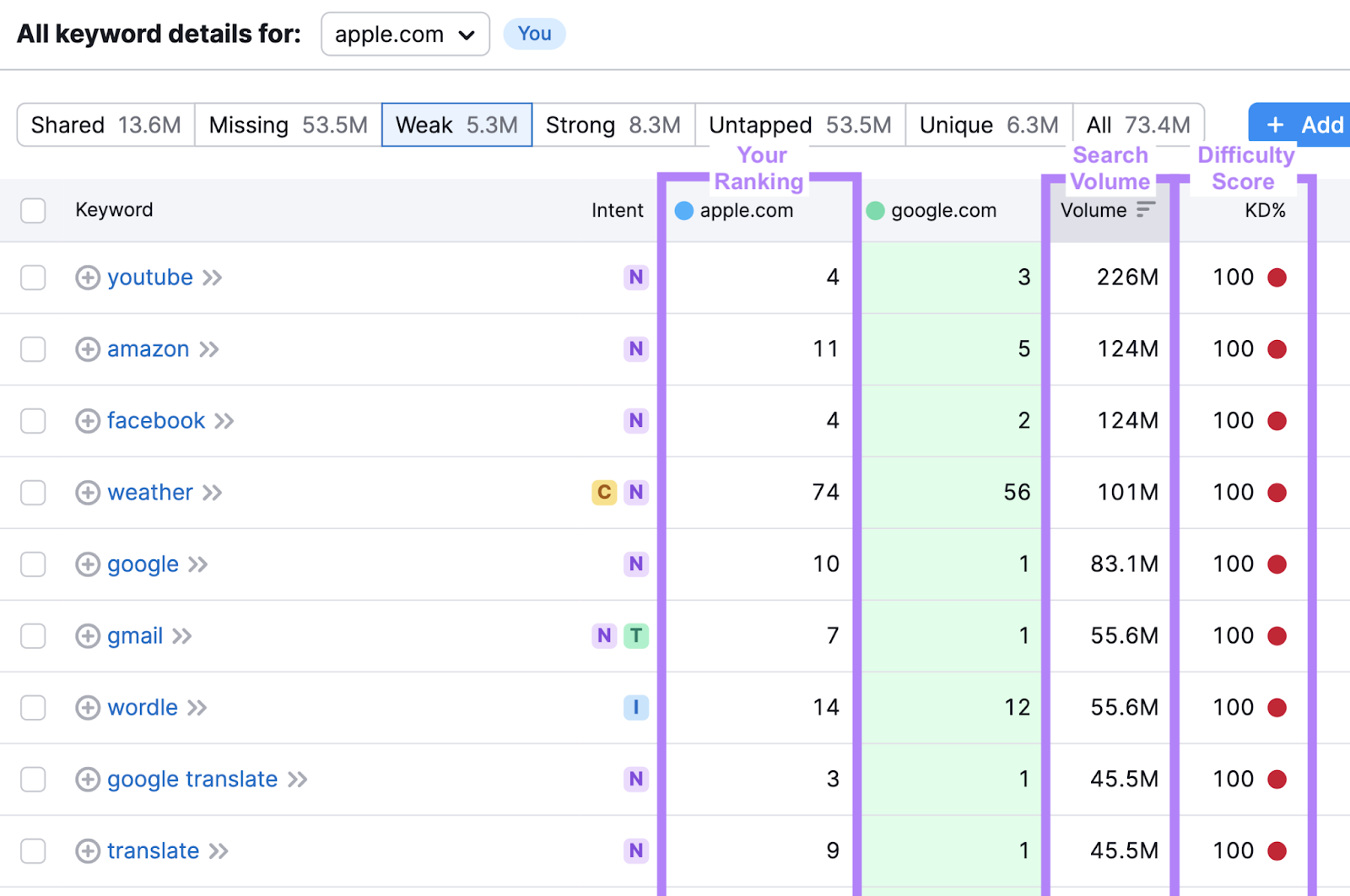
Check out our guide for detailed advice on improving your Google rankings.
Use a Competitive Pricing Strategy
Pricing is often one of the main factors in buying decisions. Especially when it comes to products that are available from multiple stores.
If you reassure customers that you’re never beaten on price (like Best Buy does), you may be more likely to secure sales.
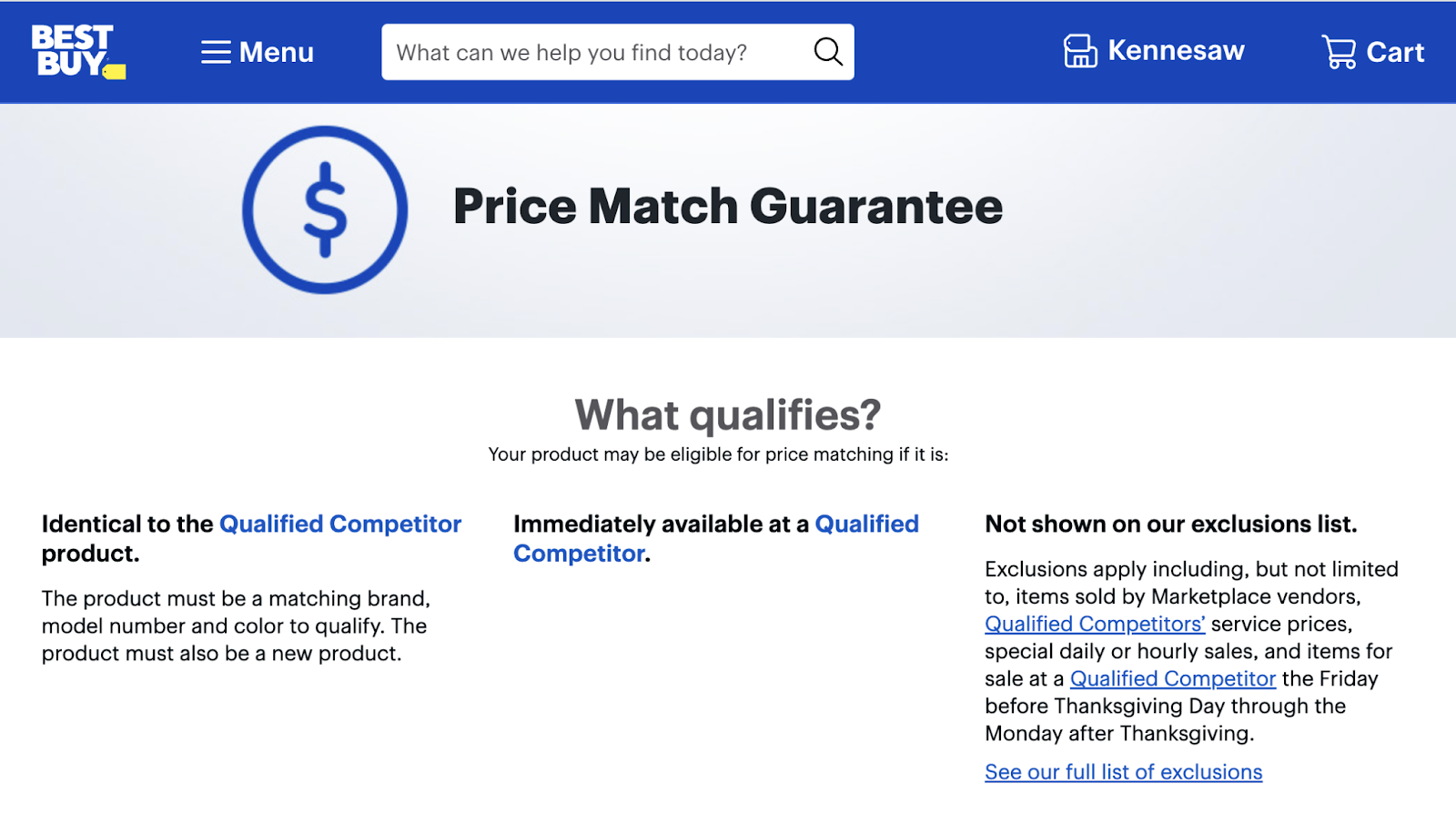
You’ll just need to make sure that this approach works for your brand identity—and your financial model.
If you can’t commit to permanently lower prices, try enticing customers with special offers and sales.
Once you have the customer on your books, they may be more likely to buy again.
Communicate a Unique Selling Proposition
A unique selling proposition (USP) explains what separates you from your competitors. Or what makes you special.
Some key elements of Apple’s USP include:
- Design excellence
- User-friendly interfaces
- Emphasis on privacy and security
Creating and communicating a strong value proposition gives customers a reason to choose your brand. So, it can play a key role in increasing your market share.
Be Innovative
Whether it’s introducing new product features or bringing a new service to the market, innovations can help your business stand out from the crowd. And solve consumer needs that no one else can.
You’ll need to conduct market research to make informed decisions about any needed research and development (R&D) designed to fuel innovation.
For example, you can use the Consumer Surveys app to gather feedback about your ideas. And monitor trends in consumer sentiments and behaviors.
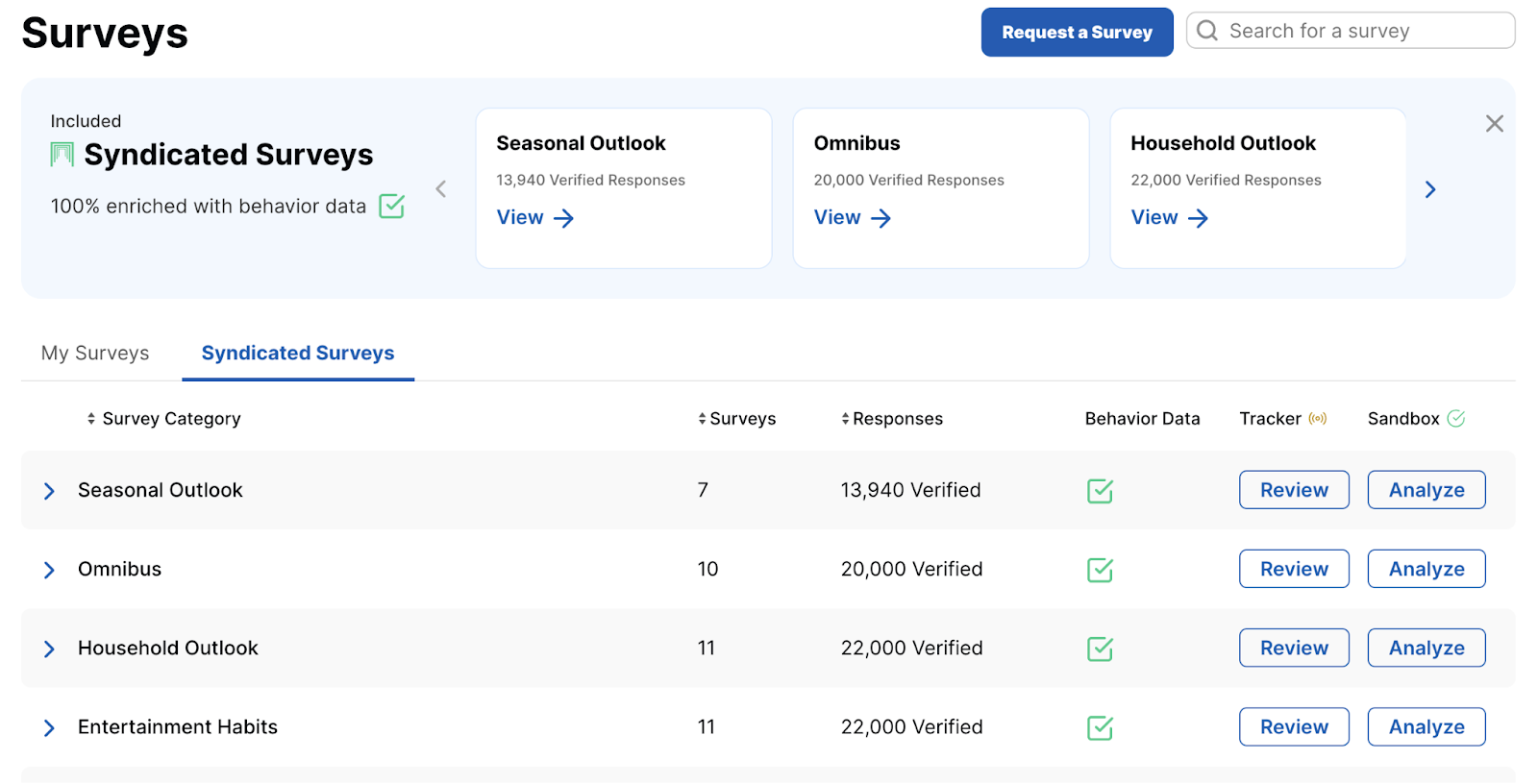
Strengthen Customer Loyalty
The stronger your customer loyalty, the less likely you are to lose market share to competitors.
Not only are loyal customers more likely to make repeat purchases (or stay subscribed to your service), but they’re also more likely to recommend your brand to others.
Here are some of the best ways to build loyalty:
- Deliver great customer service
- Launch rewards and referral programs
- Offer exclusive deals to existing customers
- Solicit and act upon customer feedback
One of the best ways to keep previous customers engaged is through email marketing. Check out our guide for advice on making it work for your brand.
Target New Demographics
Expanding your target audience into new demographics can be one of the most effective ways to increase your market share.
Consider the story of the Stanley Quencher.
This durable water bottle was originally marketed to construction workers and outdoor enthusiasts.
But when the company pivoted to targeting women, sales skyrocketed.

The strategy shift helped Stanley grow its annual revenue from $70 million to $750 million in four years, CNBC reported.
Acquire Your Competitors
If you have the capital available, acquiring or merging with a competitor could be the most efficient way to increase your market share.
For example, Facebook (now Meta) acquired WhatsApp to strengthen its position in the messaging space.
While Sephora acquired Feelunique to support its expansion into the U.K. market.
Learn from Key Players in Your Industry
By analyzing the key players in your industry, you can discover ways to emulate their success. And identify gaps in the market.
Then, use these insights to increase your market share.
Here are some of the best tools for competitive analyses:
- Traffic Analytics: Learn where your competitors get their traffic from and what audiences they attract. You can also discover their most visited pages and much more.
- Organic Research: See which organic keywords drive the most traffic to your competitors’ sites. And analyze their top-ranking pages.
- Advertising Research: Get insights into your competitors’ paid search strategies. You can see what keywords they’re bidding on, view their ads history, and more.
- EyeOn: Find out when your competitors publish new blog posts, social posts, Google Search Ads, and webpages. You can track their social engagement, too.
To try these tools and dozens more, start your free Semrush trial today.
